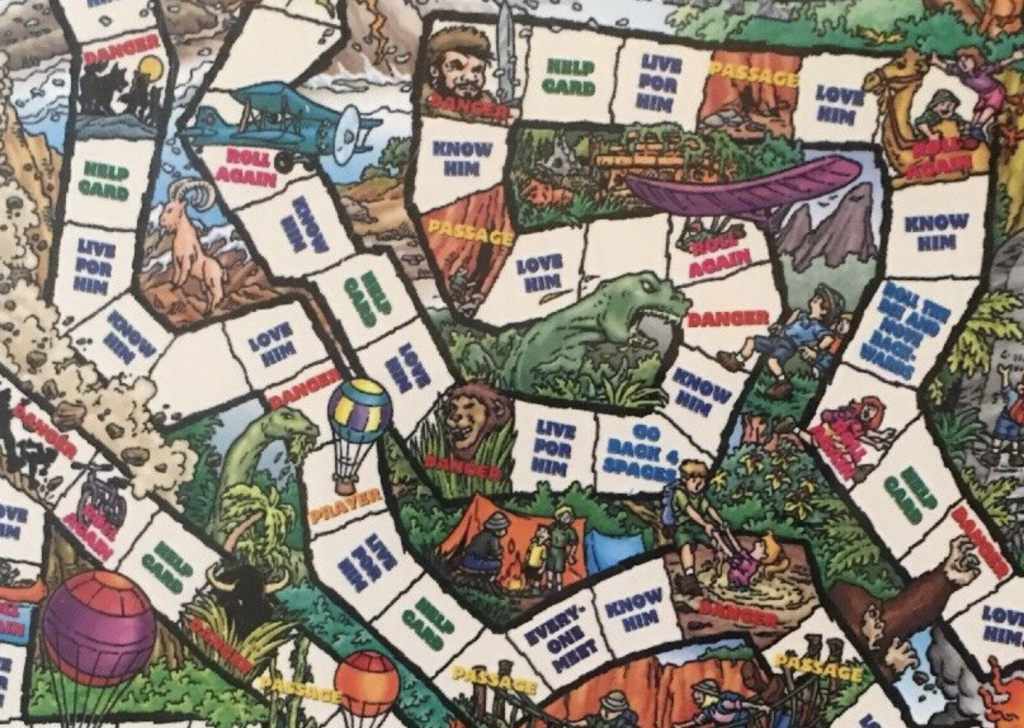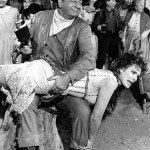This tweet caught my eye yesterday:
This board game from Focus on the Family is just wow. I don't even know where to begin. pic.twitter.com/ibuE3mvRGc
— Cindy Wang Brandt (@cindywangbrandt) April 12, 2020
From the illustrations—which we’ll get to in a moment—I’d have guessed that the game came out in the 1980s. I did some digging and found more images, and the box has a copyright date of 2001.
Here’s the game’s description:
Experience fun, excitement and adventure as you travel too far off places teaching the gospel to isolated tribes! The great adventure game is a fast paced game that lets players to learn spiritual truths and biblical principles while having uproarious fun together. As part of a missionary team, you’ll hack your way through the jungles of Africa, climb treacherous mountains, race to the middle east to witness to a sultan and much more! Build a foundation of faith and fun with the Great Adventure Game!
Hmm, published in 2001. This likely means the game was designed before September 11th. You can tell, because it references traveling to the middle east to “witness to a sultan.” After September 11th, Americans’ views of the middle east changed, particularly among conservatives.
This game makes me think of the Cooper Kids adventure series books. There’s a rope bridge in Escape from the Island of Aquarius, and the picture of two children at some sort of jungle ruins above brings to mind The Deadly Curse of Toco-Rey, which took place in South America.
For the most part, evangelicals seem unaware of the role racism and white supremacy has played in western missionary efforts for centuries. I grew up reading missionary biographies that treated portrayed Africans as primitive savages as a matter of course. White westerners were the heroes.
Can you see the scary, primitive African? Because I can. This sort of portrayal shapes how people view the world, and contributes to ongoing false and harmful western images of Africa.
Notice, too, how the game turns all this missionary work into a quasi safari adventure, complete with alligators and tarantulas and jaguars. Other countries are like this—wild and scary. Particularly Africa. I’m no expert and would love to read some papers analyzing this, but this focus on animals and scary wildlife feels to me like a marker that a place is not civilized.
I’m reminded of a local put put golf place where each hole represents somewhere around the world—the Eiffel Tower, the Great Wall of China, the ruins of the Parthenon, and so forth. Each continent had 4-5 holes. Africa was represented by the pyramids, and by multiple holes graced only by wild animals. This struck me as odd because every other continent was represented by buildings or places. (I don’t remember whether South America was even represented, now that I think about it.)
A treasure chest at the bottom of the ocean? A sting ray, an octopus, a shark, and scuba diving? Who exactly are these intrepid missionaries trying to convert, the starfish?
So, um, yes, those are dinosaurs. Yes really! Look in the middle of the picture, and then down to toward the lower left. Some portion of evangelicals believe there are dinosaurs still alive today, either in the Amazon or in the Congo or both; they share stories of explorers and others who have supposedly encountered these animals. And since these same evangelicals believe the earth was created 6,000 years ago, it seems plausible to them that at least some dinosaurs might have survived both the global flood and the brief ice age that followed. Hence, I assume, their inclusion here.
Overall, I’m struck by the fact that so little in this game has anything to do with people. You would think that a game about being missionaries would involve assessing a community’s needs, digging wells or providing medical care, building relationships with local leaders, and things along these lines. Instead, the only people we see are a scary looking African peaking out from behind some bushes and a Middle Easterner with a dagger who is literally labeled “danger.”
There are as many dinosaurs in this board game as there are humans to be converted. And even the humans aren’t there to be converted—they’re there to be scary. This isn’t a game about being a missionary; it’s a glorified safari hyped up on an extra dose of self centered whiteness.
This game wasn’t put out by a fringe publisher, either—it was put out by Focus on the Family. Is this really how Focus on the Family wanted to shape children’s perspectives toward missionary work—with a focus on danger and on wildlife safari, and not on people? How many missionaries encounter active volcanoes? No wonder there are problems with evangelicals missionary activity.
There is so much going on here and none of it is good.
I have a Patreon! Please support my writing!



















